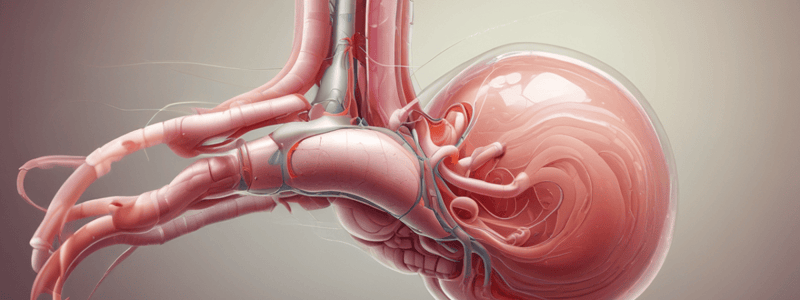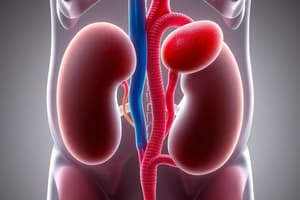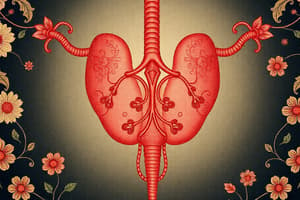Podcast
Questions and Answers
What is the function of the ureters in the urinary system?
What is the function of the ureters in the urinary system?
- To filter waste and excess fluids from the blood
- To store urine until it is eliminated from the body
- To regulate blood pressure
- To transport urine from the kidneys to the urinary bladder (correct)
How many layers does the wall of the urinary tract have?
How many layers does the wall of the urinary tract have?
- Three (correct)
- Six
- Four
- Five
What type of epithelium makes up the mucosa of the ureters?
What type of epithelium makes up the mucosa of the ureters?
- Cuboidal epithelium
- Transitional epithelium (correct)
- Columnar epithelium
- Squamous epithelium
What is the significance of the folds in the mucosa of the ureters?
What is the significance of the folds in the mucosa of the ureters?
What is the composition of the muscularis layer in the ureters?
What is the composition of the muscularis layer in the ureters?
Where are the ureters located in relation to the posterior abdominal wall?
Where are the ureters located in relation to the posterior abdominal wall?
What is the origin of each ureter?
What is the origin of each ureter?
What is the outermost layer of the ureters?
What is the outermost layer of the ureters?
What is the primary function of the ovaries in the female reproductive system?
What is the primary function of the ovaries in the female reproductive system?
During embryonic development, what is the origin of the ovaries?
During embryonic development, what is the origin of the ovaries?
What is the main function of the uterine tubes in the female reproductive system?
What is the main function of the uterine tubes in the female reproductive system?
What is the term for the collective structures of the uterine tubes, uterus, and vagina?
What is the term for the collective structures of the uterine tubes, uterus, and vagina?
What is the normal position of the uterus in the female reproductive system?
What is the normal position of the uterus in the female reproductive system?
What is the function of the vulva in the female reproductive system?
What is the function of the vulva in the female reproductive system?
What is the anatomical relation of the ovaries to the uterine tubes?
What is the anatomical relation of the ovaries to the uterine tubes?
What is the gross anatomy of the uterine tubes?
What is the gross anatomy of the uterine tubes?
What is the function of the vagina in the female reproductive tract?
What is the function of the vagina in the female reproductive tract?
Which of the following structures supports the uterus?
Which of the following structures supports the uterus?
What is the cervix?
What is the cervix?
What is the function of the vulva?
What is the function of the vulva?
What is the hymen?
What is the hymen?
How many main parts does the uterus have?
How many main parts does the uterus have?
What is the location of the vagina in relation to the urinary bladder and urethra?
What is the location of the vagina in relation to the urinary bladder and urethra?
What is the function of the vagina during childbirth?
What is the function of the vagina during childbirth?
What is the name of the muscle in the wall of the urinary bladder?
What is the name of the muscle in the wall of the urinary bladder?
What is the composition of the mucosa in the urinary bladder?
What is the composition of the mucosa in the urinary bladder?
What is the function of the rugae in the mucosa of the urinary bladder?
What is the function of the rugae in the mucosa of the urinary bladder?
What is the arrangement of the detrusor muscle in the muscularis layer?
What is the arrangement of the detrusor muscle in the muscularis layer?
What is the outer layer of the urinary bladder composed of?
What is the outer layer of the urinary bladder composed of?
What is the function of the internal urethral sphincter?
What is the function of the internal urethral sphincter?
What is the origin of the urethra?
What is the origin of the urethra?
What is the difference between the outer layer of the urinary bladder in the superior and inferior regions?
What is the difference between the outer layer of the urinary bladder in the superior and inferior regions?
What type of tissue composes the outer layer of the ureters?
What type of tissue composes the outer layer of the ureters?
Where is the urinary bladder located?
Where is the urinary bladder located?
What is the shape of the urinary bladder when it is empty?
What is the shape of the urinary bladder when it is empty?
Where do the ureters enter the urinary bladder?
Where do the ureters enter the urinary bladder?
What is the name of the triangular region on the posteroinferior aspect of the urinary bladder?
What is the name of the triangular region on the posteroinferior aspect of the urinary bladder?
In males, where is the urinary bladder located in relation to the rectum?
In males, where is the urinary bladder located in relation to the rectum?
In females, where is the urinary bladder located in relation to the uterus?
In females, where is the urinary bladder located in relation to the uterus?
What is the function of the urinary bladder?
What is the function of the urinary bladder?
What is the anatomical relationship between the urinary bladder and the rectum in males?
What is the anatomical relationship between the urinary bladder and the rectum in males?
In which direction does the apex of the urinary bladder point?
In which direction does the apex of the urinary bladder point?
Where do the ureters enter the urinary bladder?
Where do the ureters enter the urinary bladder?
What is the name of the triangular region on the posteroinferior aspect of the urinary bladder?
What is the name of the triangular region on the posteroinferior aspect of the urinary bladder?
In females, where is the urinary bladder located in relation to the uterus?
In females, where is the urinary bladder located in relation to the uterus?
What is the location of the urinary bladder in the pelvic cavity?
What is the location of the urinary bladder in the pelvic cavity?
What is the layer of the ureter that allows it to stretch when filled with urine?
What is the layer of the ureter that allows it to stretch when filled with urine?
Where do the ureters originate from?
Where do the ureters originate from?
What type of tissue composes the adventitia of the ureters?
What type of tissue composes the adventitia of the ureters?
What is the function of the urinary bladder?
What is the function of the urinary bladder?
What is the shape of the lumen in the ureters?
What is the shape of the lumen in the ureters?
How many smooth muscle layers make up the muscularis of the ureters?
How many smooth muscle layers make up the muscularis of the ureters?
What is the function of the folds in the mucosa of the ureters?
What is the function of the folds in the mucosa of the ureters?
What is the relationship of the ureters to the posterior abdominal wall?
What is the relationship of the ureters to the posterior abdominal wall?
What is the function of the ureters in the urinary system?
What is the function of the ureters in the urinary system?
What is the layer of the urinary tract that is outermost?
What is the layer of the urinary tract that is outermost?
What is the function of the internal urethral sphincter?
What is the function of the internal urethral sphincter?
What is the composition of the muscularis layer in the urinary bladder?
What is the composition of the muscularis layer in the urinary bladder?
What is the significance of the rugae in the mucosa of the urinary bladder?
What is the significance of the rugae in the mucosa of the urinary bladder?
What is the origin of the urethra?
What is the origin of the urethra?
What is the outer layer of the urinary bladder composed of?
What is the outer layer of the urinary bladder composed of?
What is the difference between the outer layer of the urinary bladder in the superior and inferior regions?
What is the difference between the outer layer of the urinary bladder in the superior and inferior regions?
What is the function of the detrusor muscle during micturition?
What is the function of the detrusor muscle during micturition?
What is the primary function of the urethra?
What is the primary function of the urethra?
What is the primary function of the vagina in the female reproductive tract?
What is the primary function of the vagina in the female reproductive tract?
What structures support the uterus?
What structures support the uterus?
What is the location of the vagina in relation to the urinary bladder and urethra?
What is the location of the vagina in relation to the urinary bladder and urethra?
What is the function of the hymen?
What is the function of the hymen?
What is the anatomical relation of the ovaries to the uterine tubes?
What is the anatomical relation of the ovaries to the uterine tubes?
How many main parts does the uterus have?
How many main parts does the uterus have?
What is the function of the vagina during childbirth?
What is the function of the vagina during childbirth?
What is the vulva?
What is the vulva?
What is the collective term for the uterine tubes, uterus, and vagina?
What is the collective term for the uterine tubes, uterus, and vagina?
What is the primary function of the ovaries in the female reproductive system?
What is the primary function of the ovaries in the female reproductive system?
What is the normal position of the uterus in the female reproductive system?
What is the normal position of the uterus in the female reproductive system?
What is the anatomical relation of the ovaries to the uterine tubes?
What is the anatomical relation of the ovaries to the uterine tubes?
What is the gross anatomy of the uterine tubes?
What is the gross anatomy of the uterine tubes?
What is the function of the vagina in the female reproductive tract?
What is the function of the vagina in the female reproductive tract?
What is the term for the female primary sex organs or gonads?
What is the term for the female primary sex organs or gonads?
What is the collective term for the ovaries, uterine tubes, uterus, vagina, and vulva?
What is the collective term for the ovaries, uterine tubes, uterus, vagina, and vulva?
What are the female primary sex organs or gonads?
What are the female primary sex organs or gonads?
What is the collective term for the uterine tubes, uterus, and vagina?
What is the collective term for the uterine tubes, uterus, and vagina?
What is the normal position of the uterus in the female reproductive system?
What is the normal position of the uterus in the female reproductive system?
What is the function of the vulva in the female reproductive system?
What is the function of the vulva in the female reproductive system?
What is the anatomical relation of the ovaries to the uterine tubes?
What is the anatomical relation of the ovaries to the uterine tubes?
What is the function of the vagina in the female reproductive tract?
What is the function of the vagina in the female reproductive tract?
In which direction does the apex of the urinary bladder point?
In which direction does the apex of the urinary bladder point?
Where is the urinary bladder located in males in relation to the rectum?
Where is the urinary bladder located in males in relation to the rectum?
What is the name of the triangular region on the posteroinferior aspect of the urinary bladder?
What is the name of the triangular region on the posteroinferior aspect of the urinary bladder?
Where do the ureters enter the urinary bladder?
Where do the ureters enter the urinary bladder?
What is the composition of the adventitia of the ureters?
What is the composition of the adventitia of the ureters?
In females, where is the urinary bladder located in relation to the uterus?
In females, where is the urinary bladder located in relation to the uterus?
What is the shape of the urinary bladder when it is empty?
What is the shape of the urinary bladder when it is empty?
Where is the urinary bladder located in the pelvic cavity?
Where is the urinary bladder located in the pelvic cavity?
What is the unique feature of the mucosa in the ureters that allows them to stretch?
What is the unique feature of the mucosa in the ureters that allows them to stretch?
What is the location of the ureters in relation to the posterior abdominal wall?
What is the location of the ureters in relation to the posterior abdominal wall?
What is the composition of the lamina propria in the mucosa of the ureters?
What is the composition of the lamina propria in the mucosa of the ureters?
What is the arrangement of the muscularis layer in the ureters?
What is the arrangement of the muscularis layer in the ureters?
What is the origin of each ureter?
What is the origin of each ureter?
What is the outermost layer of the ureters composed of?
What is the outermost layer of the ureters composed of?
What is the function of the ureters in the urinary system?
What is the function of the ureters in the urinary system?
What is the advantage of the star-shaped lumen in the ureters?
What is the advantage of the star-shaped lumen in the ureters?
Flashcards are hidden until you start studying
Study Notes
Ureters
- Ureters are tubes that transport urine from the kidneys to the urinary bladder.
- They are retroperitoneal, sitting directly against the posterior abdominal wall, covered by parietal peritoneum on their anterior surface.
- Each ureter originates at the renal pelvis as it exits the hilum of the kidney and terminates by entering the urinary bladder.
- The wall of the ureters has three layers: mucosa, muscularis, and adventitia.
Mucosa
- The mucosa is composed of transitional epithelium with an underlying lamina propria made of fibroelastic connective tissue.
- The mucosa is folded, which gives the ureters a star-shaped lumen, allowing them to stretch when they fill with urine.
Muscularis
- The muscularis consists of two smooth muscle layers: an inner longitudinal layer and an outer circular layer.
Adventitia
- The outer layer of the ureters is an adventitia composed of areolar connective tissue, anchoring the ureters to the posterior abdominal wall.
Urinary Bladder
- The urinary bladder is a muscular sac that stores urine until it is ready to be expelled from the body.
- It is located in the pelvic cavity directly posterior to the pubic symphysis, but can ascend slightly into the abdominal cavity when it is full.
- The urinary bladder has an apex that points anteriorly and a base that is directed posteriorly.
- The ureters enter the urinary bladder at its two posterolateral angles.
- The neck of the urinary bladder is located inferiorly and is where it drains urine into the urethra to be expelled from the body.
- Internally, there is a triangular region called the trigone, defined by the two ureteric openings in the superior corners and the urethral opening in the inferior corner.
Female Reproductive System
Components and Functions
- The female reproductive system is composed of the ovaries, uterine tubes, uterus, vagina, and vulva.
- The uterus can be divided into four main parts: fundus, body, isthmus, and cervix.
Vagina
- The vagina is a fibromuscular canal that connects the uterus to the external environment.
- It is located posterior to the urinary bladder and urethra and anterior to the rectum.
- The external opening of the vagina is called the vaginal orifice and is partially guarded by a vascularised, membranous structure called the hymen.
Vulva
- The vulva is the external genitalia of the female.
Urinary Bladder Walls
Mucosa
- The mucosa is composed of transitional epithelium with an underlying lamina propria.
- It is folded to form rugae, which increases the distensibility of the urinary bladder.
- The rugae flatten out when the bladder fills with urine.
- The mucosa lacks these folds in the area of the trigone.
Muscularis
- The muscularis consists of a smooth muscle called the detrusor muscle, arranged in three layers: an inner longitudinal layer, a middle circular layer, and an outer longitudinal layer.
- The addition of a third smooth muscle layer allows the urinary bladder to squeeze urine out when the detrusor muscle contracts during micturition.
Adventitia/Serosa
- The outer layer of the urinary bladder is mostly an adventitia composed of areolar connective tissue, as it lies outside of the peritoneal cavity.
- However, its superior surface is covered by parietal peritoneum, making the outer layer in this region a serosa composed of simple squamous epithelium with underlying areolar connective tissue.
Ureters
- Ureters are tubes that transport urine from the kidneys to the urinary bladder.
- They are retroperitoneal, sitting directly against the posterior abdominal wall, covered by parietal peritoneum on their anterior surface.
- Each ureter originates at the renal pelvis as it exits the hilum of the kidney and terminates by entering the urinary bladder.
- The wall of the ureters has three layers: mucosa, muscularis, and adventitia.
Mucosa
- The mucosa is composed of transitional epithelium with an underlying lamina propria made of fibroelastic connective tissue.
- The mucosa is folded, which gives the ureters a star-shaped lumen, allowing them to stretch when they fill with urine.
Muscularis
- The muscularis consists of two smooth muscle layers: an inner longitudinal layer and an outer circular layer.
Adventitia
- The outer layer of the ureters is an adventitia composed of areolar connective tissue, anchoring the ureters to the posterior abdominal wall.
Urinary Bladder
- The urinary bladder is a muscular sac that stores urine until it is ready to be expelled from the body.
- It is located in the pelvic cavity directly posterior to the pubic symphysis, but can ascend slightly into the abdominal cavity when it is full.
- The urinary bladder has an apex that points anteriorly and a base that is directed posteriorly.
- The ureters enter the urinary bladder at its two posterolateral angles.
- The neck of the urinary bladder is located inferiorly and is where it drains urine into the urethra to be expelled from the body.
- Internally, there is a triangular region called the trigone, defined by the two ureteric openings in the superior corners and the urethral opening in the inferior corner.
Female Reproductive System
Components and Functions
- The female reproductive system is composed of the ovaries, uterine tubes, uterus, vagina, and vulva.
- The uterus can be divided into four main parts: fundus, body, isthmus, and cervix.
Vagina
- The vagina is a fibromuscular canal that connects the uterus to the external environment.
- It is located posterior to the urinary bladder and urethra and anterior to the rectum.
- The external opening of the vagina is called the vaginal orifice and is partially guarded by a vascularised, membranous structure called the hymen.
Vulva
- The vulva is the external genitalia of the female.
Urinary Bladder Walls
Mucosa
- The mucosa is composed of transitional epithelium with an underlying lamina propria.
- It is folded to form rugae, which increases the distensibility of the urinary bladder.
- The rugae flatten out when the bladder fills with urine.
- The mucosa lacks these folds in the area of the trigone.
Muscularis
- The muscularis consists of a smooth muscle called the detrusor muscle, arranged in three layers: an inner longitudinal layer, a middle circular layer, and an outer longitudinal layer.
- The addition of a third smooth muscle layer allows the urinary bladder to squeeze urine out when the detrusor muscle contracts during micturition.
Adventitia/Serosa
- The outer layer of the urinary bladder is mostly an adventitia composed of areolar connective tissue, as it lies outside of the peritoneal cavity.
- However, its superior surface is covered by parietal peritoneum, making the outer layer in this region a serosa composed of simple squamous epithelium with underlying areolar connective tissue.
Ureters
- The ureters are tubes that transport urine from the kidneys to the urinary bladder.
- They are retroperitoneal, sitting directly against the posterior abdominal wall, and are only covered by parietal peritoneum on their anterior surface.
- Each ureter originates at the renal pelvis as it exits the hilum of the kidney and terminates by entering the urinary bladder.
- The wall of the ureters has three layers: an inner mucosa, a middle muscularis, and an outer serosa or adventitia.
Layers of the Ureters
- Mucosa: composed of transitional epithelium with an underlying lamina propria made of fibroelastic connective tissue, allowing the ureters to stretch when they fill with urine.
- The mucosa is folded, giving the ureters a star-shaped lumen that can increase in size when the ureters are stretched.
- Muscularis: consists of two smooth muscle layers - an inner longitudinal layer and an outer circular layer, opposite to the arrangement in the GI tract.
- Adventitia: composed of areolar connective tissue, anchoring the ureters to the posterior abdominal wall.
Urinary Bladder
- The urinary bladder is a muscular sac that stores urine until it is ready to be expelled from the body.
- It is located in the pelvic cavity, directly posterior to the pubic symphysis, but can ascend slightly into the abdominal cavity when it is full.
- The urinary bladder has an apex that points anteriorly and a base that is directed posteriorly.
- The ureters enter the urinary bladder at its two posterolateral angles.
- The neck of the urinary bladder is located inferiorly and is where it drains urine into the urethra to be expelled from the body.
Anatomical Relations of the Urinary Bladder
- In males, the urinary bladder sits directly anterior to the rectum and superior to the prostate gland.
- In females, the urinary bladder sits anteroinferior to the uterus and directly anterior to the vagina.
Features of the Urinary Bladder
- The trigone is a triangular region on the posteroinferior aspect of the urinary bladder, defined by the two ureteric openings in the superior corners and the urethral opening in the inferior corner.
- The trigone is smooth, unlike the rest of the internal surface which has mucosal folds called rugae.
Female Reproductive System
- The female reproductive system is composed of the ovaries, uterine tubes, uterus, vagina, and vulva.
- The ovaries are the female primary sex organs or gonads.
- The uterine tubes, uterus, and vagina are collectively referred to as the female reproductive tract.
Components and Functions of the Female Reproductive System
- Ovaries: produce eggs and hormones.
- Uterine tubes: transport eggs from the ovaries to the uterus.
- Uterus: nurtures a fertilized egg during pregnancy.
- Vagina: allows for the passage of a fetus during childbirth and serves as a conduit for menstrual flow.
- Vulva: protects the opening of the vagina and surrounding tissues.
Studying That Suits You
Use AI to generate personalized quizzes and flashcards to suit your learning preferences.





